For this episode Scot talks sports! One sport in particular. A Japanese sport which may be new to you. It’s the wonderful game of Park Golf, and we give it a glowing deep dive.
Small club, big ball, rubber tee, and you’re ready to hit the course. Listen to stories about Park Golf from Japan and adventures I have in America.
I talk with Kris Beyer Jones from Destroyer Park Golf for an interview with the first park golf course in America, and some of my usual unusual hijinks with my friends Jeff Clemens and Alex Yocum.
Find Destroyer Park Golf at https://destroyerparkgolf.com/
Find the International Park Golf Association of America (IPGAA) at https://ipgaa.com/
Find Wormburner Park Golf at https://www.wormburnerparkgolf.com/
And find the Japanese Park Golf Association at https://www.parkgolf.or.jp/
Here’s the episode transcript:
—————
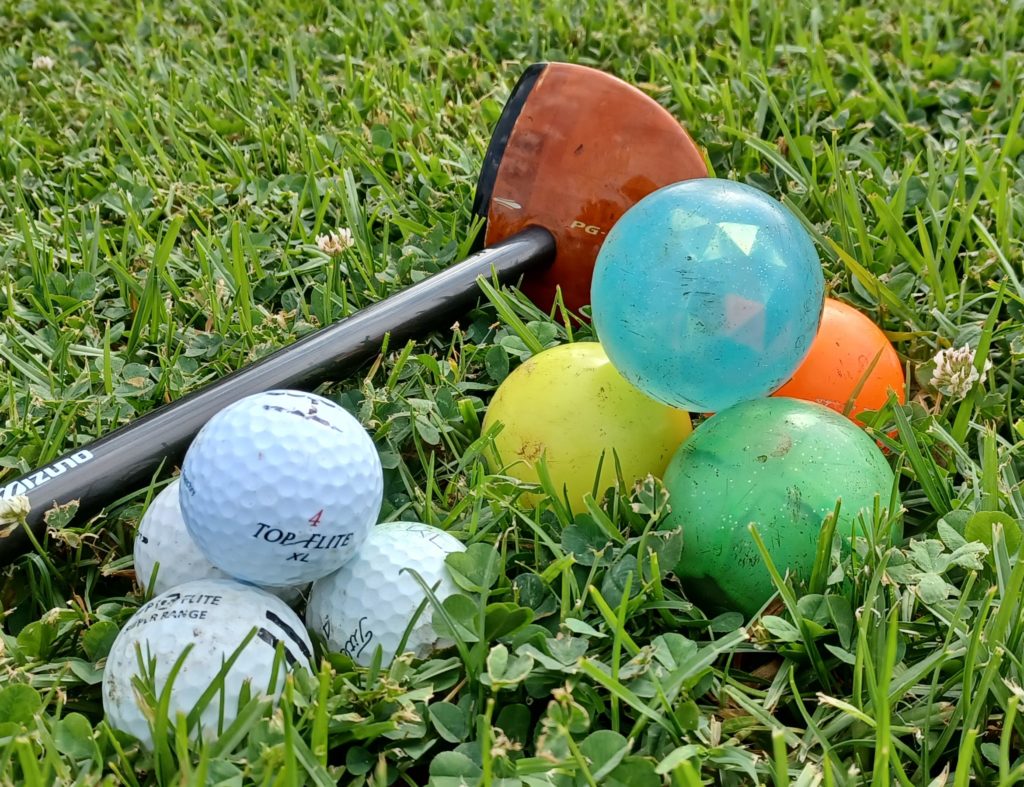
Ah, sports. I’m not much of a sports guy anymore. I mean I certainly had my phases, both as a player and as a fan, both in my childhood…that was the end of that sentence. Both of those were in my childhood.
That’s why it’s weird to me that I found a totally new sport, and then became an avid player and fan of it, completely in my adulthood. This sport may be new to you, too, and if it is, please allow me to proudly introduce you to – the game of Park Golf.
Throughout my childhood I had played and then quit a number of sports, or rather, I would often hit a ceiling on both my natural athletic ability AND my willingness to practice things past when they stopped being fun. But as a kid I had done tee ball and then baseball, soccer for a little bit early on, basketball for a bit later, and track in 7th grade as well.
All of those were over by high school, though, where I was on the high school tennis team for one year as a freshman before not making the team again my sophomore year.
You know what sophomore me thought of that? “Whatever.” because you know what sophomore me thought of pretty much everything? “Whatever.”
But on the ‘fan’ side of things, as a child growing up in a Suburb of Kansas City, I was, of course, into the Royals for baseball and the Chiefs for football. Basketball was trickier since there was no pro team nearby, I think the Chicago Bulls were the closest to us geographically, but the Kansas Jayhawks were in Lawrence just a half hour from us and they pretty much filled all the same fandom needs that a pro team would.
Now, like a lot of things, that all changed when I went to Japan. At first, I remember trying to keep up in absurd ways. Having my dad record football games and then mail me the tapes. But that stopped pretty quickly.
The only game that NHK, which is the main Japanese television network, carried live, was the Superbowl, which because of the time difference, their Sunday night game actually airs on early Monday morning in Japan time. Some expats tried each year to get something going, but the morning vibe, along with the strangeness of the game being broadcast, but none of the commercials, a lot of the time we were watching the players standing and waiting for ad breaks to end and eating like eggs or donuts or something.
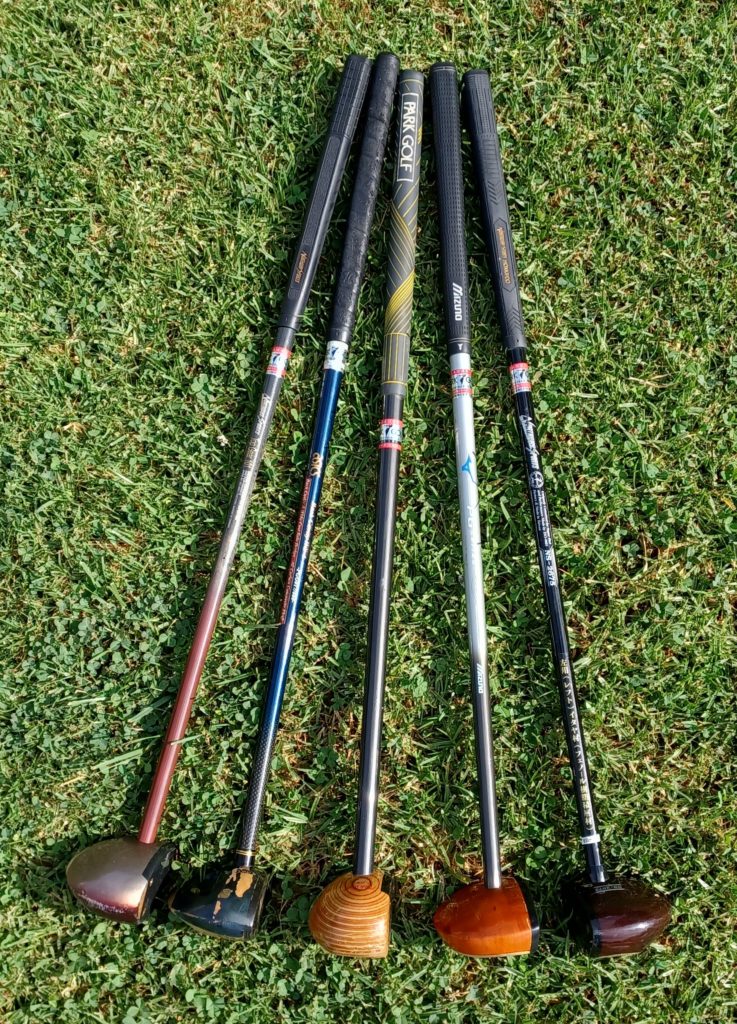
I tried to get into some Japanese sports too. Went to a couple of Japanese baseball games, I tried to watch some sumo. But it wasn’t until I moved to Hokkaido that a sport truly took hold of me again. Now, I’d have guessed that sport would have been skiing. I had liked skiing as a kid, and I had even tried to go skiing once in Japan, but they didn’t have any boots in my size, so actually, I ended up spending my first ski trip in Japan just sitting while everyone else skied.
When I applied for my next job in Japan it was with the JET Programme. A program that places native English speakers into schools and town halls to help with language and culture exchange. But in order to get a position on JET, I had to go back to the US for an interview. I had put Hokkaido as one of my top choices, and I was keen not to have a repeat of my first Japanese ski trip, so there during the hottest part of the summer, in Kansas – the flattest state in the US, I bought some ski boots in my size and hauled them back to Japan with me.
I did end up getting placed in Hokkaido. Very very far north, Hokkaido, and I skied, some. But my real sport was something we accidentally stumbled upon during my first summer there, and that sport was park golf.
I had lived in Japan for over a year in Kyushu and it wasn’t until I moved to Hokkaido that I even heard of Park Golf, and that’s because even though park golf is an international sport, technically, it was invented in Hokkaido, Japan, and with the more spacious nature of Hokkaido compared to the other Japanese prefectures, that’s where the vast majority of the courses are, as well.
Wikipedia tells me Park Golf started in 1983. Invented in the town of Makubetsu, Japan, which is on the northern island of Hokkaido. Although it also says the sport is like a cross between golf and croquet, which I think is off. There’s no wickets or hitting other players’ balls or anything. I’d say it’s more like the midway point between regular golf and mini golf.
You get to crack the ball when you hit it more than mini golf, and the ball is bigger, like a baseball or a billiards ball, so you have a much larger target than in normal golf and you can put extra English, extra spin on the thing when you hit it. No spinning windmills, or statues, but plenty of land and sand challenges.
Rules run roughly the same as golf. You count your strokes for each hole, add them up at the end, low scores are good and high scores are bad. That’s all the same.
Wikipedia also says the creators wanted it to be really accessible to everyone, so it’s designed to be played with really simple equipment. For park golf you only need one ball, one tee, and one club, making it cheap to play and to buy equipment for.
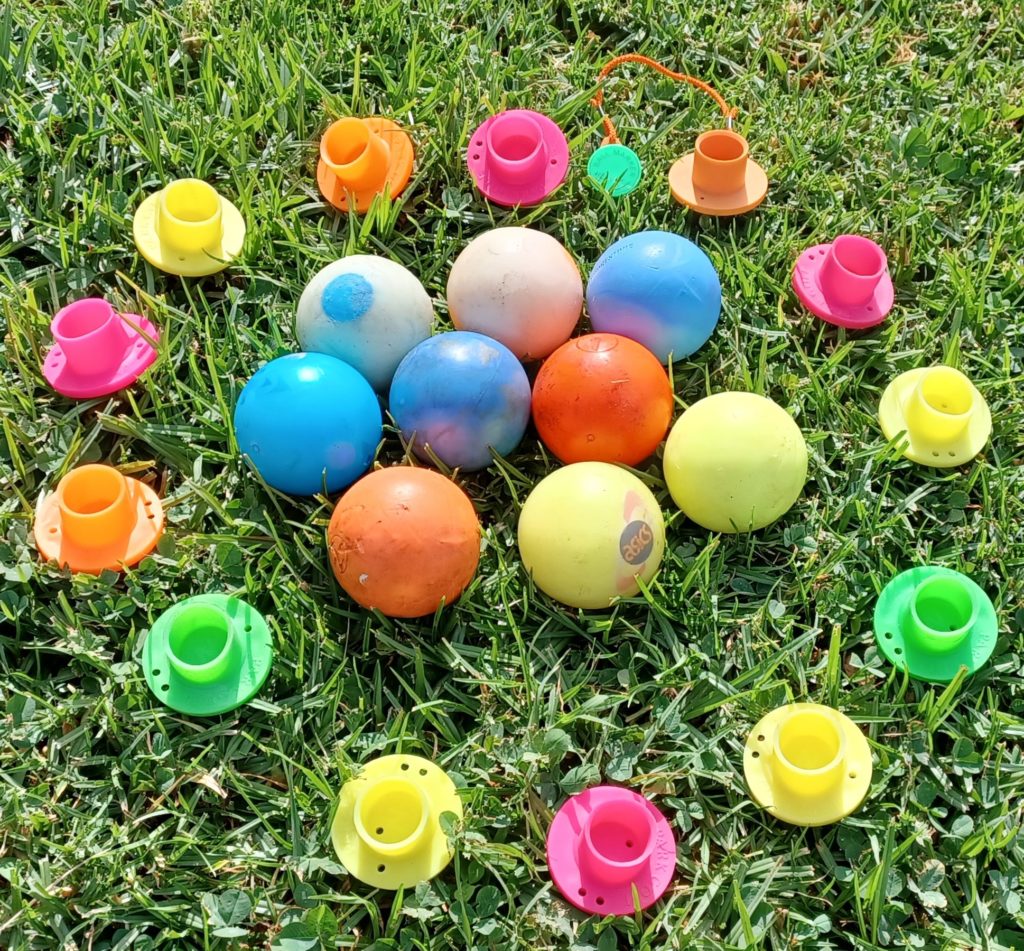
Speaking of equipment, driving, chipping, and putting are all done with that same stubby club. I’d say the club looks like you took a regular putter shaft and handle, then shortened it and stuck the head of a driver on the end of it. I’m 6’1 and I hunch over a lot to get a good hit with one. Most Japanese people weren’t that tall, especially the older Japanese people I would often see out playing park golf, and so they didn’t have to hunch over nearly as much, but there is still more of a – well, I’ll call it a ‘hunch and whack’ style to hitting a park golf ball more than the wind up and follow through of a regular golf swing.
Meanwhile what you’re hitting is a hard plastic ball 60 mm wide, or about 2 ⅜ inches. So that’s just a little smaller than a tennis ball, which is 65-68mm. Many are just a simple solid color. I started off with those, but I enjoyed splurging on one new ball to begin each new park golf season, and I eventually opted for something cooler. Maybe a ball with marblized color or gold flecks that sparkle in the sun, or one where the outer plastic is clear but you can see an inner complex geodesic dome structure inside of it.
With the larger ball, it also makes sense that you would have a larger hole. The park golf hole is between 200-216mm across, making it around 8-8.5 inches in diameter, pretty much twice as wide as the 4.25 inch hole for regular golf. Which means we are dealing with a park golf hole that has 4 times as much area as a regular golf hole when you multiply it out.
Holes are supposed to be limited to a maximum of 100 meters long, that’s 109 yards, and a 9-hole course is supposed to total a maximum length of 500 meters, which is 547 yards. But I gotta say I definitely played many courses in Hokkaido that exceeded both of those limits, and some of my favorite courses were the longest and most sprawling, so I’m not sure how strictly they monitor that rule.
Wikipedia notes that despite it being accessible for every age, there are a vast majority of “the parkers,” which is what it says park golf players are called, but that’s my first time ever hearing that term, but it says that most of them, by far, are retirees. And I definitely can concur, but I also think there’re a bunch of reasons why that is, and it doesn’t seem so strange to me.
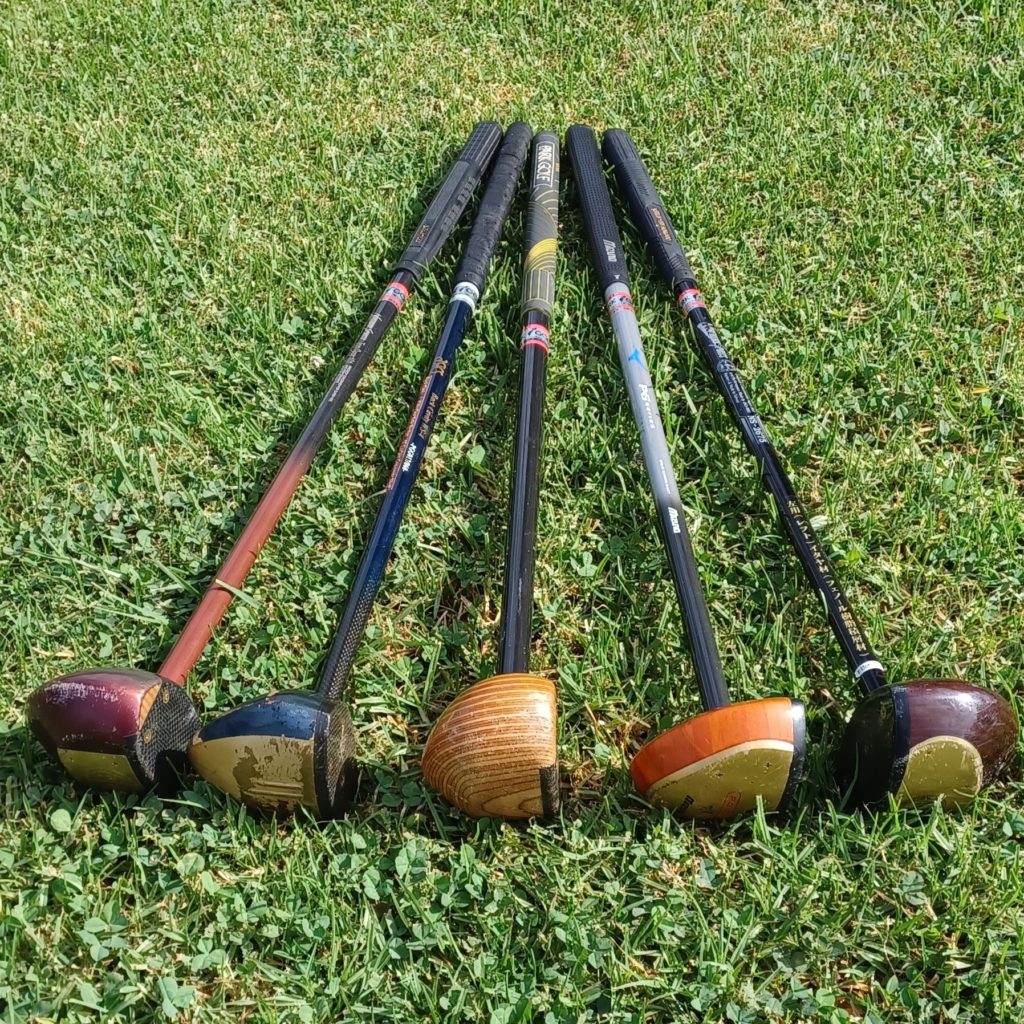
First off, the best times to park golf were during times when non-retirees would be either at work or school, so it makes total sense that would become a spot where you’d see it as an activity for retirees during that time.
Japan also has a strong culture of activities planned and available for its older population that doesn’t so much exist in the United States. It’s definitely built into the culture, but it’s also built into Japanese society. A lot of care and attention gets paid to elder care and quality of life, so I also saw park golf being encouraged as an engaging physical activity less demanding than actual golf for an older player, but it still got people outside, walking, hitting, and socializing in fresh air.
I would probably say the next largest group after older Japanese players were younger foreigner players. My data may be really skewed though because every time I went park golfing I saw one of those.
As a group we rarely, but sometimes, clashed with the oyajis – which translates to ‘old man,’ as we referred to the older Japanese players, who often did their own thing, but sometimes would jump in to “help” our group and let us know we weren’t quite playing right.
We’d thank them, but when they left go right back to what we were doing, which was play our modified version of the game. For example – there is an out of bounds, referred to by players as OB, but when we played, unless there were other players nearby, there was no OB rule.
If you could play it, you could play it. Something oyajis really tsked at us if they saw, but it was important for us becaue we had money riding on these scores. 100 yen a hole, usually, with the possibility of going on a hot streak and winning enough for a meal paid for by your less lucky friend. And those meals? Those were the most delicious kind.
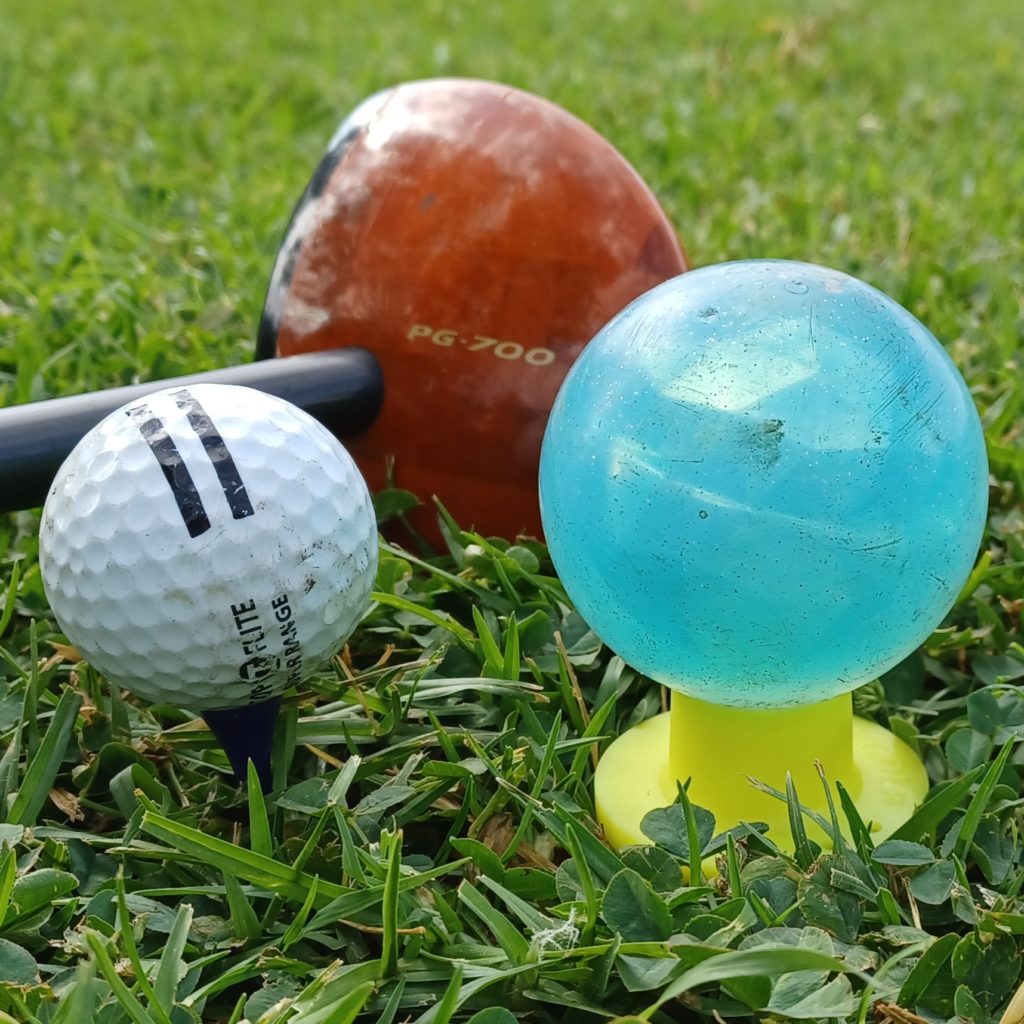
Hokkaido snow would start sticking to the ground in October and then stay around on the ground until April. A full six months of snow. Playing park golf in the fresh Hokkaido air was an amazing way to spend the six non-snowy months outdoors. It was challenging enough to be continually fun, but easy enough to do with new people. The perfect pastime.
My job on JET I was an assistant English teacher in my town’s junior high schools, and I would often be done with work while students were still at school, with several hours of sunlight still left, so I would meet up with other teachers, we’d grab our clubs and play whatever course was up next.
We had favorites, but also any time someone discovered a new course, it was a good enough excuse to hit that one up next.
And every town seemed to have at least one course. Usually more than one. Usually way more.
I think the first Hokkaido town I lived in had some nearby, but like with groceries, the best collection of Park Golf courses in the area were in the city of Nayoro. There were a ton there. And really all the towns around, too.
The second Hokkaido city I lived in was where I really got into playing park golf more often, because there were over twenty different courses within a 15-minute radius of our spot in Takikawa. (including some really nice ones in Shintotsukawa, the next town over)
There were also courses set up and maintained by onsens and hot spring hotels, all across the island. In fact, my all-time favorite course is at an onsen hotel in Kenbuchi, Hokkaido, where there are 36 holes up in the hills with just spectacular layouts and natural views of the local river valley.
Another evolution to our gaikokujijn-basion of park golf was the ‘jump tee.’ A normal park golf tee is a squat little cylinder about an inch tall with a wide base, all made out of this rubbery plastic. You only use it on your first shot, like a normal golf tee. But unlike a normal golf tee, it didn’t really give you much lift at all. You could try to scoop under it, or pop it up, but it didn’t really work well no matter how many good attempts we gave it.
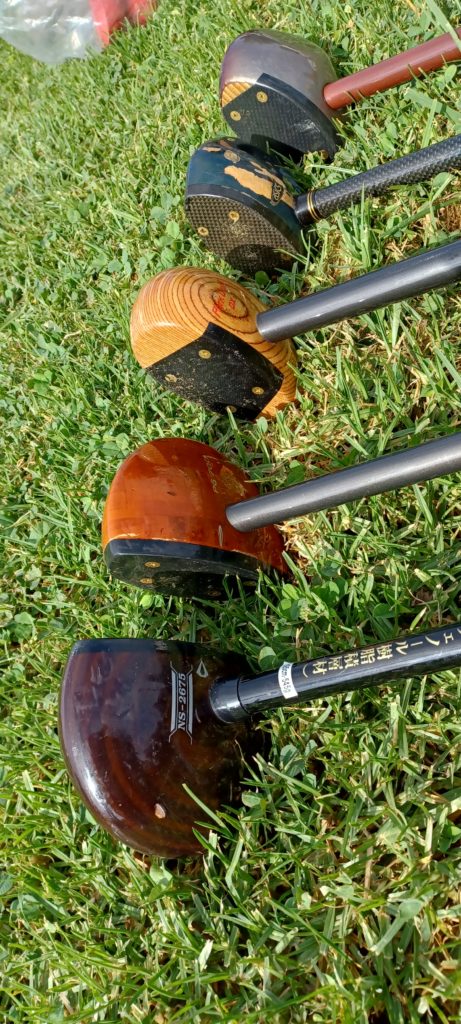
That’s why we invented – the jump tee. The jump tee’s sole purpose was to give the park golf ball some lift. To let us pop it up and over instead of going around some obstacles like the course designers wanted us to. The jump tee was made from two – or sometimes, rarely, three – regular park golf tees stacked on top of each other, and then driving the ball while it’s balanced atop this tower.
It took some getting used to, and some harkening back to those long dormant tee-ball skills, but the jump tee opened our game up vertically, and probably intensified the attachment we all felt to our special brand of this sport, and for four years when there wasn’t snow on the ground I played it pretty regularly.
Winter wasn’t free of park golf activities, though. that’s when the oyajis would shed their old wares and get new ones, so that meant the start of a new type of season for me.
Like I said before, park golf is a game where you only need one club, but some of the more well-off or serious Japanese players liked to make sure they had a new “one club” each season.
Eventually new “one clubs” become backup “one clubs,” and backup “one clubs” become clutter, so they get taken to the recycle shop.
This wonderful, magical, amazing place in Japan called “The Recycle Shop.” In the US it would be called a used goods store, or a thrift shop. Like Goodwill or the Salvation army, but, again, like many things in Japan, it has a completely different feel than its American counterpart.
Here, I think the thrift stores are looked at as sort of the last stop for something. Like places without too much expectation or status. I think American thrift stores are probably ranked just a notch above a flea market, maybe.
In Japan, though, the recycle shop seems like the first place things go, and you can find all manner of items there. From nice clothes, electronics, furniture, and interesting odds and ends to oftentimes very decently priced park golf equipment.
Park Golf Balls were a different matter. Because there is some good distance to these holes, they got whacked around quite a bit so I didn’t see used balls often, and when I did see them, they were pretty banged up. This was another reason I would get a new one each year, especially since new ones were only ten to twenty dollars, or maybe twenty-five dollars if you want to spring for something really nice.
Now recycle shops do. not. pay. much. For the stuff they buy from you. I can say that from many first-hand experiences. But you don’t sell stuff to them to get rich, you do it for the love of the game, and because you got ‘good gets’ from the recycle shop before so when it’s time to move your stuff, you just go there first.
I mean, you hit up your friends first, and try to offload stuff they might want for a decent amount, and then take anything that they don’t want to the recycle shop after that.
But yeah, I’d scour recycle shops for clothes in my size, exercise equipment, tables, and chairs sometimes, but whatever reason I was there for initially, I’d always check for park golf equipment before I left, and collected a bunch of my own clubs and gear that way.
Not so that I could have a set of clubs for me, remember this is a sport where you only need one club, but I got a bunch so that I had enough for a group of four or two groups of four could go out park golfing. I mean I have a left-handed club, and I have never been left-handed. Not even a phase in college or nothing.
Some of the nicer park golf courses came complete with places to get scorecards and rent clubs and balls, which would usually only cost 500 to 1000 Yen, or $5-10. If you brought your own equipment it would be significantly cheaper or sometimes even free. In that sense I played enough that the used equipment I bought tended to pay for itself over the season just in saved rental fees.
But the main reason I had my own clubs was because only some park golf courses were staffed. Many were just open, near river beds or in parks, and unstaffed, so you couldn’t rent anything there, but as long as you brought your own equipment you could play for free as much as you wanted. These were the places that we really haunted over and over until they became courses we knew well.
Now each one of my clubs has a little sticker on the shaft certifying that it complies with the official size restrictions for park golf equipment, and each of those stickers cites the power of the IPGA – Which stands for the International Park Golf Association.
Just like Park Golf spread over Hokkaido, it continued to spread across Japan, all the way down to Kyushu and Okinawa. As you’d expect the more rural an area is, the more park golf courses it seems to have. The official ones are all members of the NPGA, the Nippon Park Golf Association. – Oh, I don’t know if this is at all needed, but Nippon is one of the ways to say ‘Japan’ in Japanese.
But what makes the International Park Golf Association international, of course, are the courses outside of Japan. I found a few different park golf courses in Korea, and also saw listed that there were courses in Sweden, Brazil, and Paraguay. It was hard for me to search in most of those countries, because I don’t know the language or what they might refer to park golf as, but there’s only one in all of North America. On their map of officially registered courses, this course is actually the only one the IPGA even lists outside of Japan. It’s in the United States, in Akron, New York.
Akron is a small village in upstate New York, about 40 minutes from Buffalo and 45 from Niagra Falls, and it’s the home of Destroyer Park Golf, the first Park Golf course in America.

After I came back from Japan I searched the internet for park golf in America and crossed my fingers that I could find a place to play in the US. That’s how I first learned about Destroyer Park Golf.
Now I feel like I’ve traveled all over america, except the northeast. I’ve never to New York or anywhere in the New England area, so it wasn’t a place I could go in person, but when I decided on doing a park golf episode, Destroyer Park Golf was the perfect place to turn to.
That’s how I found myself one afternoon on a phone call to Akron, New York for an interview.
[INTERVIEW AUDIO]
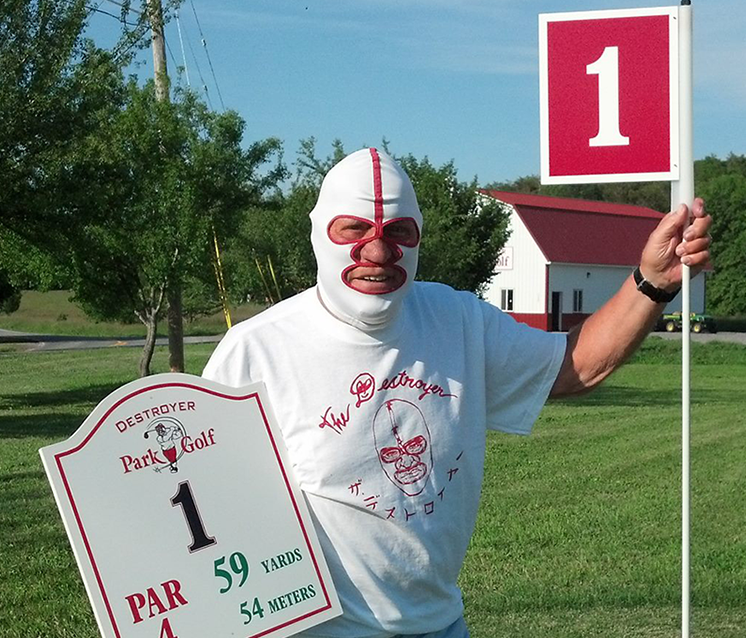
Dick Beyer, Kris’s dad, was a professional wrestler who was best known as his masked alter egos The Destroyer and Doctor X, wrestling extensively in Japan against many of the other top names of the industry during the 60s and 70s. He was huge. I was looking at clips and interviews of The Destroyer and found people ranking him as the number one masked wrestler of his time, and you can find great highlight reels of some of his matches on youtube.
The Destroyer passed away in 2019 at age 88, but a museum of his memorabilia and media from his decorated pro-wrestling career is open in the clubhouse at Destroyer Park Golf, the perfect place for any fans of The Destroyer, or park golf, to visit.
[INTERVIEW AUDIO]
So yeah, it was great talking with Kris about their course out there at Destroyer, and her dad and the sport itself. Be sure to check out their site at DestroyerParkGolf.com where they’ve done an amazing job of showing off their course and you can see the video segment we talked about, which is about 9 minutes and really good, under the ‘What is Park Golf’ tab.
I also looked up the other park golf course she mentioned. It’s called Wormburner Park Golf and it’s in Logan, Ohio. About 2 and a half hours south of Akron. Their website is WormburnerParkGolf.com Both courses have great websites and are very active on facebook.
Also of course if you’re in or around Akron New York, or Logan, Ohio, think about getting a group of friends or family together and treat yourselves to a nice day outside playing a round or two of park golf. The surprising king of all sports.
Oh, and while I had Kris on the phone and away from a nice day outside I had one final question.
[INTERVIEW AUDIO]
Uh yeah, so I should probably explain that, right? I know it’s weird. And I know I’m weird but that’s just like a little more than my usual level, right?
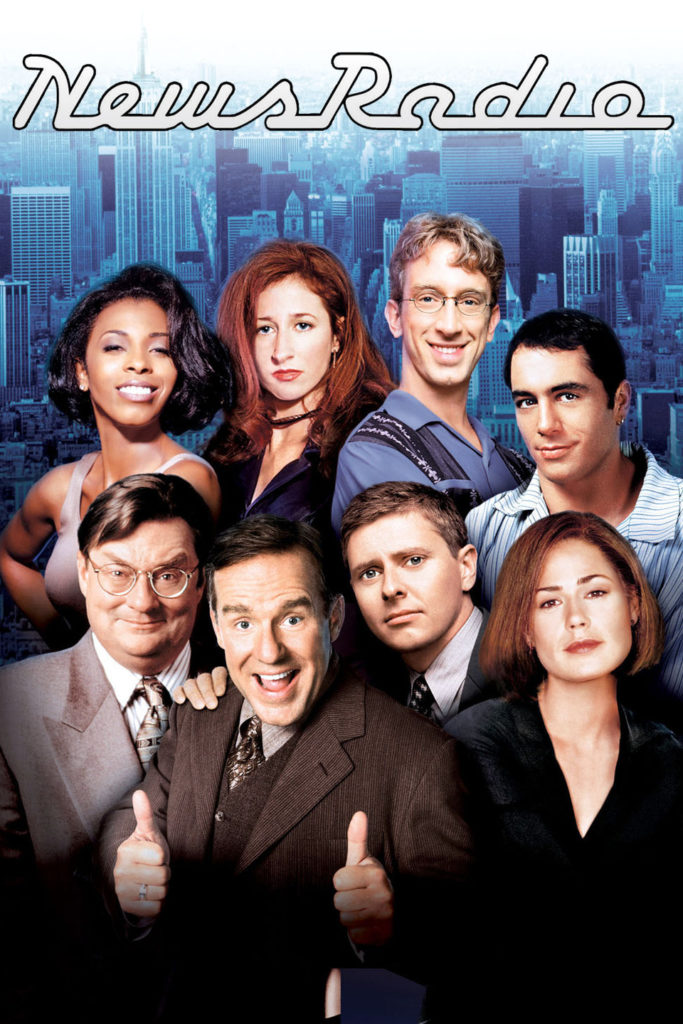
Well, there’s a 90’s sitcom I’ve always loved called News Radio. It was about a bunch of people working in a News Radio station, hence the name. There’s an episode in season 3, episode 15, titled “Rosebowl” It aired February 5th, 1997, on NBC.
The ‘A’ story is about the employees evaluating each other’s performance, and it’s great. Typical hilarious News Radio stuff, but the reason I’m bringing this episode up is because of the ‘B’ story.
In this plotline the station’s eccentric billionaire owner Jimmy James, played by Stephen Root, brings in a box of stuff to show to station manager Dave, played by Dave Foley.
[NEWS RADIO AUDIO]
This one’s way small and has the wrong writing on it. (under first tablet)
And the second tablet he pulls out is a completely different size and color.(under second tablet)
[NEWS RADIO AUDIO]
So it’s obvious that Jimmy’s bought a box of fake movie memorabilia, but Dave has to tell him because he’s oblivious.
So in this next scene, Jimmy James is sitting in the break room with the station fix-it guy Joe Garelli, played by a young Joe Rogan, and if you’re familiar with podcasts, yes – it’s that Joe Rogan, But Jimmy and Joe hatch a plan.
[NEWS RADIO AUDIO]
And so that was what made me ask Kris the question about if there was a word I could say to do the same thing for me in my quest.
So how does it turn out for Jimmy and Joe in court?
[NEWS RADIO AUDIO]
An the gag here is he’s a young kid.
Jimmy and Joe proceed to put on a terrible and incoherent case, and here’s what the judge has to say to them at the end:
[NEWS RADIO AUDIO]
The judge marches past the shocked courtroom as the bailiff puts the kid in cuffs giving Joe and Jimmy the sudden win. And that concept just stuck around in my brain all this time, clearly.
Some things just worm their way into my brain and then they just stay there forever. I’ve remembered the nonsense word ‘tubal cain’ for decades now. I guess similarly to how I remember the crack of hitting a park golf ball so vividly, too.
In Takikawa the closest park golf course to where we lived was one of my favorites, but exploring Hokkaido and finding new courses was part of the fun of it all.
We would go all over and try out any course we came across. Park golf was a part of where we traveled, where we camped, and where we went to the onsen.
I probably played 18 holes with friends after work 3 – 4 times a week and usually one if not both weekend days. It was, fortunately, something I shared in common with my girlfriend, with my guy friends, with my northern friends, and with my musical friends – oh yeah, I was part of a stage musical we put on in Hokkaido, but that’s a different story.
When my parents came to visit me in Hokkaido I went with my dad and he enjoyed it so much that for Christmas that year I gathered up a set of my recycle shop clubs and got them back to the states for him as a present.
What dad ended up doing was making use of an existing disc golf course that was set up where he lived. He would play there when it wasn’t being used. I couldn’t really imagine how that worked when my dad first told that, partly because I hadn’t ever played disc golf before.
Disc golf spaces your tee-off place a good distance away from your target for the hole, which is a large metal basket with a series of chains around the upper part to snare discs that hit it. The disc in disc golf is a frisbee-like disc you use to throw at the basket, eventually getting it in.
My dad was going down to the disc golf course at the nearby college and hitting park golf balls on it, going hole for hole, teeing off at the tees and having his standard for completing the hole be hitting the pole with the park golf ball.
I honestly didn’t really understand how disc golf worked until I played it myself for the first time, on a vacation to Missoula, Montana, one summer.
It turns out I really liked it. I enjoyed being outdoors, and the game, while challenging, and me being not particularly good at it, never reached the wrong side of frustration where things just shift from simply challenging to fully unpleasant.
I think I took that and added it to what I knew about myself and golf – which is that I don’t like regular golf, but I like mini golf, and I always have. I’d had many a childhood mini-golf birthday party, family mini-golf night, and teenage mini-golf date – well maybe not ‘many a’ of that last one, but a few.
I like mini golf because it’s about golf a little, but it’s also open for button mashers, like a video game, where I feel if I just bounce it off enough angles, maybe it will find the perfect throughline and get into the hole. I love putt-putt mini golf, but I don’t like regular golf. That’s just how it is.
Then I tried park golf, and I loved it. It is a mix of mini golf and golf golf, but it must be closer to mini golf because I love park golf, and I love mini golf, but I don’t like regular golf. That’s just how it is.
And then I tried disc golf, and – I loved it. So then now I love mini golf and park golf and disc golf, but I don’t like regular golf….though…am I sure of that?
Truth be told, I actually haven’t ever played a game of regular golf golf. Like never. I just assumed I wouldn’t like it, and never tested that theory. Even when I tried, and loved, every single other kind of golf I’ve encountered.
I’ve practiced putting. I’ve been to a driving range a hand full of times, I’ve spent an hour trying to make my Tiger Woods character as close to me as the game allows but I’d never played a real game of regular golf golf.
So I started asking people around me if anyone would be interested in playing a game of golf sometime.
I think this is where the divide happens with most real golf players. They can’t fathom me wanting to go out without practicing a bunch, and I really just want to play one round of golf to -more than anything else- say I’ve done it, so I’m not worried if I go out there and do awful, it’s may just a matter of finding the perfect person to humor me while I’m being awful.
[GOLFING AUDIO]
So I went with Jeff. He’s a longtime friend. I met him and his wife when they were also in Takikawa, Japan teaching English. Jeff’s a great guy anyway, and he’s a real-life Canadian on top of that, making him just about the nicest golf partner I could ever hope to find for my first round of golf ever. He lives with his family in Calgary, Canada, but they had stopped by Oakland to see us for a few days on their way back home from Comicon in San Diego.
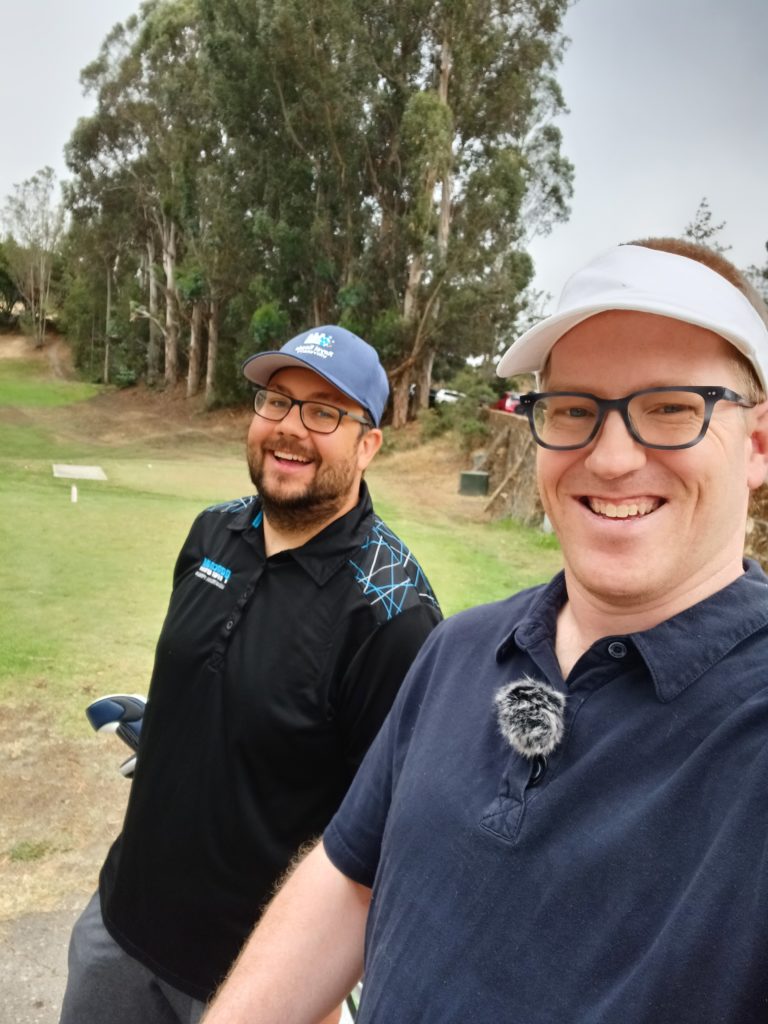
[GOLFING AUDIO]
This is the Lake Chabot Golf Course, about 10 minutes away from the studio.
It’s a par 3 and when we got there it really looked sort of like a park golf course..
Lake Chabot has a larger 18 hole course, but the 9 hole course is a total of 1023 yards, making it a short course in terms of regular golf, which I guess is just what a ‘par-3 course’ means to golf folk.
[GOLFING AUDIO]
The “ting” of hitting the ball was very satisfying, I remembered that being the case from driving ranges years ago, and indeed it is still the same. So we continued to play the first couple of holes.
[GOLFING AUDIO]
That was the only shot I hit with that club.
And then Jeff wisely noted that we were sort of away from any prying eyes or other players, and pointed out that this could be a pretty good spot, for some ‘ulterior motive-ing.’
[GOLFING AUDIO]
And as satisfying as that “ting” was on the golf club, the “crack” of that park golf ball, the first one I’ve hit in years, was actually far, far more satisfying, I have to say.
[GOLFING AUDIO]
I’m pretty sure Jeff and I had just played the first hole of park golf that has ever been played in California, actually probably on the whole west coast.
We continued on to the next hole.
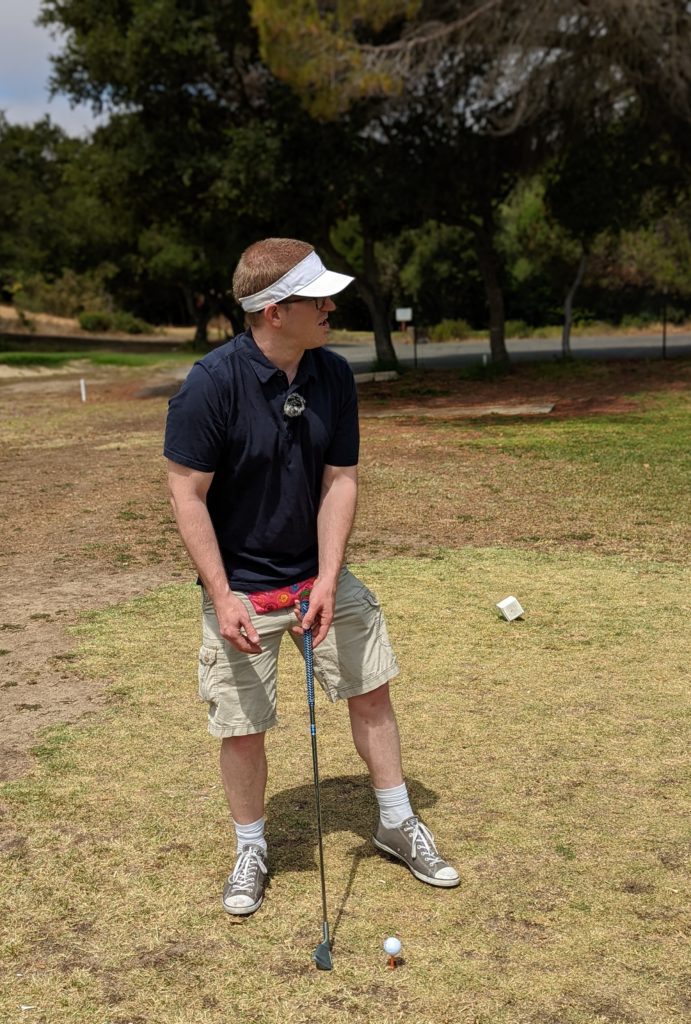
[GOLFING AUDIO]
I had to look for my first hit and eventually wrote it off as a gift to the out of bounds gods, and took a drop to continue, but by that time the party behind us had caught up so I just finished the hole for my regular golf ball and not my park golf ball.
We just played regular golf after that, which went pretty so -so, with the one exception of this hole.
[GOLFING AUDIO]
That’s right, the most impressive golf highlight I have is of me achieving….the average. Wooo.
[GOLFING AUDIO]
And then a mere 80ish minutes after we started, Jeff and I found ourselves at the 9th hole, the final one for this course.
[GOLFING AUDIO]
[INTERVIEW AUDIO]
Okay – I want to break in here for a second. I know that corn dog. This is from years ago and I know the exact corn dog he’s talking about.
It’s from this highway foodstand in Mikasa, a small town just north of Sapporo, that we would pass by when we were going there, but he’s right. This place served the best corn dogs I’ve ever had, and I grew up in the midwest going to county fairs and old settler’s days every summer, so that’s actually an incredubly high bar.
I’ve even been thinking about making an entire episode about corn dogs, and I still might, but this corn dog in Mikasa was the real deal. So much so that before I became a vegetarian, and I was vegetarian for six years, I did a training wheels period of like six months before leaving Japan where I was completely vegetarian EXCEPT for two things, and one of them was corn dogs from Mikasa.
Okay, back to my conversation with Jeff.
[INTERVIEW AUDIO]
The compliments are nice, but the real reason I was riding high at that moment was that I had just gotten to do something that I had been joking about for years, but really actually wanted to try.
I played my first round of golf! Golf golf!
Not a thing I think I’ll do very regularly, but I’d definitely be down to go again sometime.
I’d be far more than down if I knew I could slip in some more park golf, though.
Jeff and I even talked about this on our drive home
[GOLFING AUDIO]
So a little while later I asked my friend Alex if he’d be up to try something new, and the two of us headed back to the Lake Chabot Golf Course with only one club each.
[GOLFING AUDIO]
This is Omar I’m talking to, and now I’m handing him my club so he can examine it for himself.
I paid for the round and we were out the door a second later…
[GOLFING AUDIO]
So I explained the whole News Radio and secret word thing Kris had given me to Alex. I hadn’t told him about it first because I really was nervous and I genuinely wasn’t sure if I was going to back out of doing it or not.
We made our way to the first tee, and I set up to hit first, about to play park golf on this par 3 golf course.
[GOLFING AUDIO]
Now I recorded it before and it’s still good on this mic, but this time since I was playing with permission, I had brought a better device to really capture the sound of the crack. Here is that same shot from my field recorder.
[GOLFING AUDIO]
Oh man, did you hear that? Whew. I love that sound.
Next up was Alex, hitting a park golf ball for the first time ever.
[GOLFING AUDIO]
He had hit it off into the woods beside the fairway, which he went and got and then rehit much straighter, but even so once again listen to the perfect sound that the field recorder captured of his first hit.
[GOLFING AUDIO]
We proceeded to play the nine holes out, and we got to satisfyingly hit the park golf ball tons of times. Tons and tons of times, actually, because we’re not great, and it took us a while to get it into each hole.
[GOLFING AUDIO]
while also experiencing more than a few near misses due to the hole being a quarter of the size that it should be, comparatively.
[GOLFING AUDIO]
I keep expressing that same sentiment. I think if I become a regular Park Golf on golf Golf Course player, that’s gonna be something I’ll just have to make peace with.
Okay so now I’ll get back to our round at the end of the ninth hole…
[GOLFING AUDIO]
I mean I’m the first person to do that in the entire Pacific Time Zone ever? Wow. Amazing. Am I glowing? Can you tell? Do microphones hear glowing?
Hey, It’s probably not all that different from how Neil Armstrong felt walking on the moon. Well actually, Destroyer Park Golf should be Neil Armstong. I guess we would be Buzz Aldrin, then. Wait, no, Wormburner in Ohio would be Buzz. Okay then, Michael Collins. I mean, I’ll take that. The Park Golf Michael Collins? Oh, you mean Scot Maupin? Yeah, I’ve been called worse.
And with that, Park Golf becomes the next entry into the Perfectorium, the index of perfect things.
Go to the show’s website perfectshowpodcast.com to see pictures and videos related to this and each episode, – for this one I will have pictures of my equipment, me playing golf, and a video of my awkward but effective swing, and more.
You can see all the entries to the Perfectorium at the direct link for it, perfectshowpodcast.com/perfectorium.
Special thanks to Kris Beyer Jones, Jeff Clemens, and Alex Yocum for being on this episode and putting up with a large dose of my nonsense.
Visit Destroyer Park Golf in Akron, New York or at destroyerparkgolf.com
Visit Wormburner Park Golf in Logan, Ohio or at wormburnerparkgolf.com
Find the Japanese Park Golf Association at parkgolf.or.jp
And the International Park Golf Association of America at ipgaa.com
You can find the info and links for all the musical artists in the show notes and on this episode’s webpage.
As always, if you’d like to contact the show, you can email PerfectShowShow@gmail.com, and connect on Twitter, Youtube or Instagram to the name PerfectShowShow.
This episode was recorded and mixed at Morena Studios in Oakland, California.
Again, I’ll remind you of the very obvious fact that I don’t make these on a schedule, so subscribing via your favorite pod portal really is the best way to get every episode, And if you are enjoying these and want to drop us a rating or review, please do. It’s the easiest way to support the show. I asked for new reviews last episode and that worked, so I’ll do it one more time.
Ratings and reviews help people find the show, and I’m hoping for that to become the number one way people discover this podcast, which is currently me hitting them up with a call or text saying ‘Hey, I have a podcast, would you be able to help me out with something for it?’
Also if you do know me in person, we can just find some grass somewhere with a bit of space and I’ll let you try out hitting the park golf ball a few times, because if you just give it one good crack, you’ll understand everything immediately.
And remember, there’s no such thing as a secret word that just automatically helps things go your way, not in court and not in golf that’s definitely not a thing, but…I mean, just in case…lemme cover my bases here real quick: “abra kedabra tubal cain destroyer candyman.” Okay, thanks.
Anyway, until next time. I’m Scot Maupin, and thanks for listening to The Perfect Show.
—————–
Music from this episode by:
Avishka31 – https://www.fiverr.com/avishka31
Bastereon – https://www.fiverr.com/bastereon
Brrrrravo – https://www.fiverr.com/brrrrravo
dawnshire – https://www.fiverr.com/dawnshire
desparee – https://www.fiverr.com/desparee
Gelyanov – https://www.fiverr.com/gelyanov
Gui Moraes – https://www.fiverr.com/guimoraes
Isehgal – https://www.fiverr.com/isehgal
kgrapofficial – https://www.fiverr.com/kgrapofficial
Nearbysound – https://www.fiverr.com/nearbysound
rito_shopify – https://www.fiverr.com/rito_shopify
Yashchaware – https://www.fiverr.com/yashchaware
Aandy Valentine – https://www.fiverr.com/aandyvalentine
From the Free Music Archive and used under a Creative Commons License:
Komiku – https://freemusicarchive.org/music/Komiku
School – https://freemusicarchive.org/music/Komiku/Captain_Glouglous_Incredible_Week_Soundtrack/mall_1328/